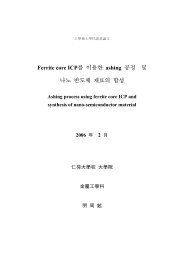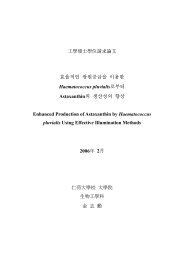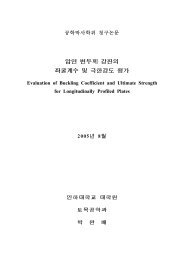저작자표시-비영리-변경금지 2.0 대한민국 이용자는 아래의 조건을 ...
저작자표시-비영리-변경금지 2.0 대한민국 이용자는 아래의 조건을 ...
저작자표시-비영리-변경금지 2.0 대한민국 이용자는 아래의 조건을 ...
You also want an ePaper? Increase the reach of your titles
YUMPU automatically turns print PDFs into web optimized ePapers that Google loves.
nanocomposites enhanced greatly with the addition of CNFs, and the<br />
CNFs content at maximum tensile strength was only 2 wt% regardless<br />
of the preparation methods. These results are due to the physical<br />
interaction between the PBS matrix and reinforced-CNFs with high<br />
mechanical property, and more uniform dispersion at the 2 wt%<br />
loading of CNFs. However, the tensile strength of nanocomposites<br />
slightly started to decrease after 2 wt%, which attributed to the<br />
aggregation of CNFs in the PBS matrix. It was also found that<br />
nanocomposites prepared by the SOAM method showed relatively<br />
higher tensile strength than those of the other preparation methods.<br />
As the CNFs content increased, the slight decrease in the elongation<br />
at break was observed as indicated in Figure 2(b). This variation was<br />
resulted in part from the modifications in crystalline fraction of the PBS<br />
matrix as more CNFs added. It thus is believed that the CNFs led to a<br />
decrease in ductility and an increase in brittleness.5 In addition, we<br />
can found that the decrease in the elongation at break was less in<br />
nanocomposite obtained from the SOAM method than in those of two<br />
other preparation methods.<br />
The relative state of dispersion of CNFs inside the PBS matrix was<br />
compared by scanning electron microscopy (SEM) as presented in<br />
34







